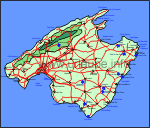General information of Mallorca

Most of the visitors of Mallorca only need few information before they go on holiday: Hotel, beach, nightlife . But there are so many things to be discovered in Mallorca like different landscapes with plenty of sightseeings, a colourful and versatile flora and fauna and, of course, some isolated dream beaches where the normal "Joe Public" tourist doesn't get lost. Subsequently, some general information of Mallorca will follow.
Geographical data, inhabitants, tourism

Mallorca is accessible from many german big and small airports and an average of two hours are needed to get there by plane. During the approach, there is an entire archipielago visible which is the Balearic Islands. They are located on the eastern side of the Mediterranean Sea in front of the spanish east coast and Mallorca is the biggest of them with an extension of 3.640 km². In total they are 151 islands that compose together the autonomone community of Spain. Two of them are known as further popular holiday islands and are located right in the neighbourhood of Mallorca: Menorca with 716 km² at the east and Ibiza with 573 km² at the south-west. There are two further islands that are barely inhabited but worth to mention that are Formentera (83 km²) and the rock island Cabrera, which is unter nature conservancy. The remaining 145 little islands are not inhabited.
Geographically, Mallorca is located between 39°15' and 39°57' northern lattitude and 2°19' and 3°28' eastern lattitude. This is approximately at the level of Valencia and 240 Km distant from there. Barcelona is located at the same distance but in the northern direction.
By now 2007, Mallorca counts in total more than 700.000 inhabitants that are mainly spread over the bigger cities. In the region of the circumference of the capital Palma, more than half of the total of the inhabitants live there, thereafter, the most inhabitated areas are Manacor, Inca, Pollenca und Andratx. During the whole year, approximately 8 millions of tourists visit the island, thereunder approximately 3 million Germans. More than 22.000 germans are domiciled here.
Landscapes of Mallorca
If you want to describe Mallorca and its regions with the help of a map, it would be appropriate to compare it with a rhomb which is standing on one point end so that from the north point to Cap Formentor to the south point Cap de Ses Salines there is an approximately air-line distance 80 km. From the west to the east, thus from Sant Elm with the dragon island off the coast of it, Sa Dragonera, the island expands up to Cala Ratjada over more than 100 km. The total length of the coast is of approximately 550 km.
Scenically, Mallorca can be divided in three major areas. The nortwest coast is extended from the island Dragonera up to Cap Formentor of Serra de Tramuntana, a mountain range with a maximum Width of 20 km which summit, the Puig Major, has a height of 1445. Due to the soft coats of limestone, there are many cave systems that are also accessible for tourists. But there are only few streets there and one has to consider some vertiginous curves.
The mountain range in the opposite side at the southeastern trend of the coast can at the most be described as an extensive hilly landscape with its difference in altitude of 500: the Serra de Lievant extends from the north all over the Artà - area down to Santanyi.
Between the mountain chains, inside the island, the plain Es Plà or, also calles, Llunara del Centro is extended. Here, only few mountain ranges tower, as so the Puig de Randa with a height of 549 metres at the north of Llucmajor.
The plain is surrounded by bathing bays at the northeast coast by Pollenca and Alcudia und at the southwest coast around Palma, where approximately 10 km further in eastern direction the famous beach of S`Arenal is located.
Vegetation
No matter at what time of the year: Mallorca is always green and captivates additionally depending of the season with colourful flowerages. In total, 1500 sorts of flowering plants. Throughout the summer there are many kinds of flowers like marguerites, oleander, hibiscus or gladiols and marigolds to be admired, not to forget the approxomately 100 sorts of orchids and, of course: resounding palms.
A great attraction at the beginning of the year is surely the season of the almond blossom. Between January and March, the countless white/pink blossoms of the almond trees put the tourists into an advanced pring feeling; And even in the winter time, one has the feeling to be in a much more southern holiday place due to the matured lemons and oranges.
In general, the island captivates with its wide variety of kinds of trees and beautiful forests, the holm oaks in the upper regions of Tramuntana and the extended aleppo pine forests on the rocky coastal episodes. The many little olive- and fig-trees that are cultivated on huge mountain terraces have a charm of their own.
Fauna
In Mallorca, there is no typical fauna of the island. There is no big game and the smaller species are barely spectacular: wild rabbits, rabits, rats, mice and marten, sometimes wild goats. Birds and insects are rather to see and in the summer, the use of mosquito repellents is to be considered.
The sorts of fish and seafood offered in the restaurants as a delicacy are only partly from the surrounding sea; Even if there are a great variety of fish beside shells, snakes and crustaceans (crabs) they are also often imported by air.

Back to the index Mallorca
Copyright: Patrick Wagner, www.tourist-guide.biz
|